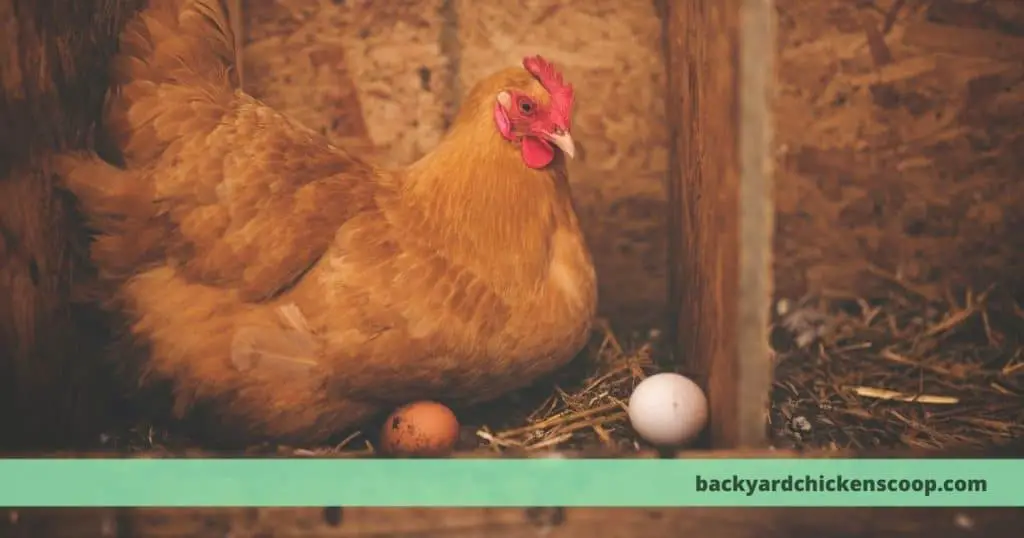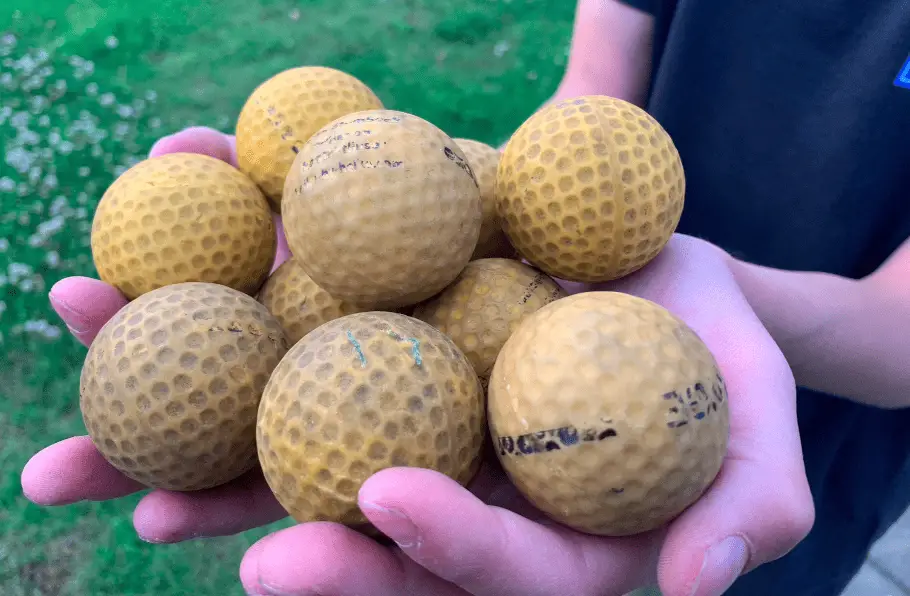I wanted to test the role of fake eggs in the nesting boxes. Do they help broody chickens lay more and do they encourage nesting behaviour? This is what I found.
Key Takeaways
- Fake eggs can be used to encourage chickens to lay their eggs in designated nesting boxes instead of random places. Placing a fake egg in a nesting box signals to chickens that it’s a safe spot to lay eggs.
- Fake eggs can be used to stimulate broody behaviour in hens and create a natural incubator.
- If multiple hens are using the same nesting box, fake eggs can be used as decoys to encourage them to use other boxes. Fake eggs cannot force chickens to start laying eggs but can help collect eggs in one location.
- Fake eggs can be made of porcelain, plastic, or even golf balls, each with its own pros and cons. DIY fake eggs can be created using materials like wood, clay, or even repurposing real eggs
If you’ve ever kept pet chickens in your backyard, then you’ve probably encountered one particularly annoying chicken habit, They often tend to lay their eggs everywhere except where they’re supposed to be – in the nesting boxes. Especially if they can roam free around the backyard.
You’ve probably found eggs on the coop floor, in the tall grass, in backyard corners, shed, or even in a dog house. That is if you’re lucky enough to find them at all.
Sometimes, you may feel as if the chickens are being intentionally stubborn just to mess with you. No matter how much effort you put into preparing fancy nesting boxes, they seem to keep finding other new spots to leave their eggs.
Fake Nest Box: See Options and Prices on Amazon
For chickens, laying eggs in nesting boxes is a learned behaviour. They don’t have any natural instinct that would drive them to lay eggs in designated places. In fact, their instinct is to hide them at a location where they will be safe from predators. If there’s no broody hen to raise them, this is exactly what the young chickens will do. So, you’ll have to assume the training duty.
One of the most efficient ways to do this is by using fake eggs for chickens. If you’ve used dummy eggs before, you know how useful they can be. If not, I’ll try to explain why are they helpful and how to use fake eggs.
Ad: I thought you’d like these…


Why Do People Put Fake Eggs in Chicken Coops? What Do Fake Eggs Do for Chickens?
The main reason why people use fake eggs is to encourage chickens to lay their eggs in nesting boxes instead of all over the place. This way you can have clean and fresh eggs every morning without the hassle of having to search the coop or yard to find them.
Placing the dummy egg in the nest box signals to the chicken that this is the place to lay the eggs. When they see that there is an untouched egg already in the nesting box, the chickens will figure out that that spot is safe from predators.

Using fake eggs to get chickens to use nesting boxes also has health benefits. When a chicken lays an egg on the ground or on the coop floor, it can easily get tainted and unfit for human use. Besides the dirt you’ll have to clean, faeces lying on the ground can coil the eggs causing bacterial contamination.
In addition, eggs lying around can break easily. This can cause hens to start eating eggs which can further lead to them eventually breaking and eating eggs from the nesting boxes. This creates a habit that is very difficult to get rid of.
Dummy eggs can also help you encourage your hen to go broody providing you with a perfect natural incubator and broody box. Large farms and corporate breeders’ primary interest is getting as many chicken products for sale as possible.

As a result, most modern chicken breeds have lost their broodiness gene. However, some small backyard chicken owners still want to propagate their flock in a natural way. Leaving some broody hen fake eggs in the nesting box may encourage the chicken to start sitting on them. When your hen commits to sitting on the eggs, you can replace fakes with real ones.
If you have more than a handful of chickens in your backyard, you may face the problem of “communal nesting”. This means that multiple hens are laying eggs in the same nesting box which they recognize as a “good one”.
When this happens, chickens can become overstressed due to the lack of comfort in the shared nest, and eggs can fall out of the box and break. The best way to deal with this situation is to use fake eggs as a decoy and place them in the unused nesting boxes. This will assure the hens that other boxes are also good enough to lay there.
Fake Nest Box: See Options and Prices on Amazon
Do Fake Eggs Help Chickens Lay?
As I mentioned above, fake eggs can help you in a lot of ways but they can’t help you force chickens to start laying eggs. The hens will “lay when they lay” and there’s not much you can do about it. At what age will a pullet start laying eggs depends on several factors, with the breed of the particular chicken being the most influential.
They can also start laying eggs sooner or later depending on nutrition, exposure to daylight, and stress and comfort levels.
Dummy eggs will also do nothing to increase egg production. A hen will lay a certain number of eggs regardless of putting fake eggs in nesting boxes. However, using them will still get you more eggs daily.
When all the eggs are in the nesting boxes, it’s much easier to collect them and you won’t leave any hidden in the grass or elsewhere in the backyard. Furthermore, you’ll have fewer broken eggs.
You also need to know…
Essentials
Does a Chicken Know If Its Egg is Fertilized?
As we all know, chickens don’t need roosters to lay eggs. Still, for fertilized eggs, you’ll need a rooster to perform his mating duties. Even after only one mating session, the hen can lay fertilized eggs for up to three weeks.
However, she will not know if her eggs are fertilized or not. As some roosters can be infertile, the eggs may not be fertilized even after mating. In addition, the hen can’t even tell if the eggs are hers or laid by a different chicken.
Nevertheless, if the hen goes broody, her instinct is to form a clutch of eggs, usually around a dozen. She will then sit on the eggs trying to hatch them, fertilized or not. When broody, she may even sit on a nest filled with fake eggs or even an empty one.
Should I Be Putting Fake Eggs in Nesting Boxes?
If your hens are laying eggs all over the backyard or on the coop floor, you’ll likely have a lot of trouble collecting them. There’s a good chance you won’t even find some of them. The best thing you can do in this situation is to put fake eggs in the nesting boxes. This will stimulate hens to lay their eggs in the boxes and make your daily collecting much easier.
Besides, you’ll have fewer broken eggs, prevent bacterial contamination from the faeces found on the ground, and encourage hens to go broody if needed.
When Should I Put Fake Eggs in Nesting Boxes?
By the time your chicken starts laying eggs, you should already have prepared the fake ones to place in the nesting boxes. The point of lay to the age where the pullet lays its first eggs can vary depending on a lot of factors. On average, this should happen when they’re 16-24 weeks old.
A hen may not notice dummy eggs right away, so be patient as there may be some time before she starts laying eggs in the nesting box.
It helps if you can get at least one pullet to start laying eggs where she’s in the nesting box. Others will likely follow the leader and soon start doing the same.
At this point, I’m sure you need the free Chicken Disease Cheat Sheet
…
Plastic vs. Porcelain Fake Eggs? And Do Golf Balls Work as Fake Eggs?
When choosing what type of fake eggs to use, you have several options. For years, most backyard chicken owners used porcelain fake eggs for chicken. These dummy eggs are a frequent choice, but a lot of people are using plastic or even wooden ones.
Porcelain eggs probably resemble the real thing the most and are very hard which discourages chickens from trying to break and eat them. They may try to peck a few times but will soon give up in frustration. Nevertheless, porcelain fake eggs are probably the most expensive option available.
That’s the reason why more and more people opt for plastic dummy eggs. They’re much cheaper and also very durable. However, they’re rather light and often have bright colours provoking chickens to peck at them.
Lately, golf balls have also become a popular option. They’re very cheap and you may even get old ones for free if you have a golf course nearby. Be aware that, although they work in most cases, some chickens may see the difference between golf balls and real eggs and kick them out of the nest.

How To DIY Fake Eggs
If you prefer a DIY approach to things, you can make fake eggs by yourself. Those who are handy with wood can carve out a dummy egg and colour it to resemble real ones more. Another option is to shape them out of clay which you will later fire to make them solid.
You can even use a real egg to make a new, fake one. Using a needle, poke a hole at the top and bottom of the egg and gently blow it to empty the shell.
Then, fill it out with plaster of Paris and seal it with hot glue. When it dries, sand it down until it’s smooth and there are no bumps and you got yourself a realistic-looking fake egg.
Fake Nest Box: See Options and Prices on Amazon

Soren, a lifelong chicken enthusiast, shares his passion and expertise through BackyardChickenScoop.com. Raising chickens since childhood, he now teaches his two sons about care, life, and food origins.
Read more about us here…
